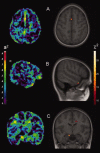Heritability of regional and global brain structure at the onset of puberty: a magnetic resonance imaging study in 9-year-old twin pairs
- PMID: 19294640
- PMCID: PMC6870645
- DOI: 10.1002/hbm.20660
Heritability of regional and global brain structure at the onset of puberty: a magnetic resonance imaging study in 9-year-old twin pairs
Abstract
Puberty represents the phase of sexual maturity, signaling the change from childhood into adulthood. During childhood and adolescence, prominent changes take place in the brain. Recently, variation in frontal, temporal, and parietal areas was found to be under varying genetic control between 5 and 19 years of age. However, at the onset of puberty, the extent to which variation in brain structures is influenced by genetic factors (heritability) is not known. Moreover, whether a direct link between human pubertal development and brain structure exists has not been studied. Here, we studied the heritability of brain structures at 9 years of age in 107 monozygotic and dizygotic twin pairs (N = 210 individuals) using volumetric MRI and voxel-based morphometry. Children showing the first signs of secondary sexual characteristics (N = 47 individuals) were compared with children without these signs, based on Tanner-stages. High heritabilities of intracranial, total brain, cerebellum, and gray and white matter volumes (up to 91%) were found. Regionally, the posterior fronto-occipital, corpus callosum, and superior longitudinal fascicles (up to 93%), and the amygdala, superior frontal and middle temporal cortices (up to 83%) were significantly heritable. The onset of secondary sexual characteristics of puberty was associated with decreased frontal and parietal gray matter densities. Thus, in 9-year-old children, global brain volumes, white matter density in fronto-occipital and superior longitudinal fascicles, and gray matter density of (pre-)frontal and temporal areas are highly heritable. Pubertal development may be directly involved in the decreases in gray matter areas that accompany the transition of our brains from childhood into adulthood.
Copyright 2009 Wiley-Liss, Inc
Figures



References
-
- Amunts K,Jancke L,Mohlberg H,Steinmetz H,Zilles K ( 2000): Interhemispheric asymmetry of the human motor cortex related to handedness and gender. Neuropsychologia 38: 304–312. - PubMed
-
- Andreasen NC ( 1995): Symptoms, signs, and diagnosis of schizophrenia. Lancet 346: 477–481. - PubMed
-
- Baaré WF,Hulshoff Pol HE,Boomsma DI,Posthuma D,De Geus EJ,Schnack HG,van Haren NE,van Oel CJ,Kahn RS ( 2001): Quantitative genetic modeling of variation in human brain morphology. Cereb Cortex 11: 816–824. - PubMed
-
- Barnea‐Goraly N,Menon V,Eckert M,Tamm L,Bammer R,Karchemskiy A,Dant CC,Reiss AL ( 2005): White matter development during childhood and adolescence: A cross‐sectional diffusion tensor imaging study. Cereb Cortex 15: 1848–1854. - PubMed
-
- Barnett JH,Heron J,Ring SM,Golding J,Goldman D,Xu K,Jones PB ( 2007): Gender‐specific effects of the catechol‐O‐methyltransferase Val108/158Met polymorphism on cognitive function in children. Am J Psychiatry 164: 142–149. - PubMed
Publication types
MeSH terms
LinkOut - more resources
Full Text Sources
Medical

